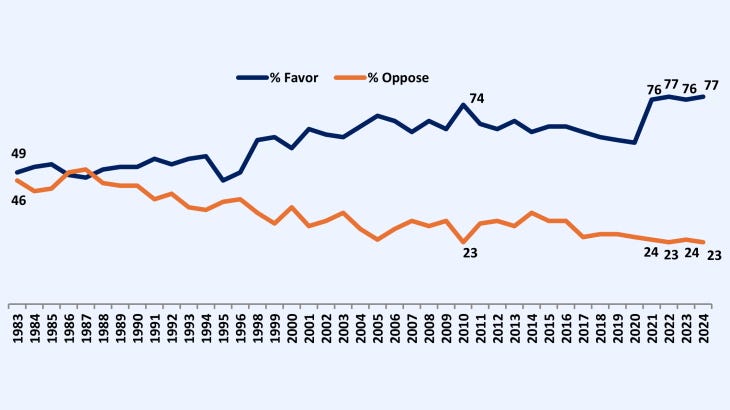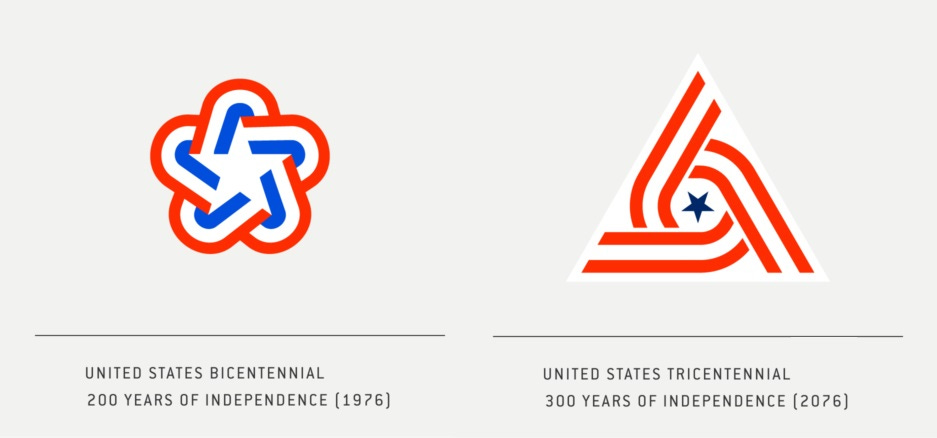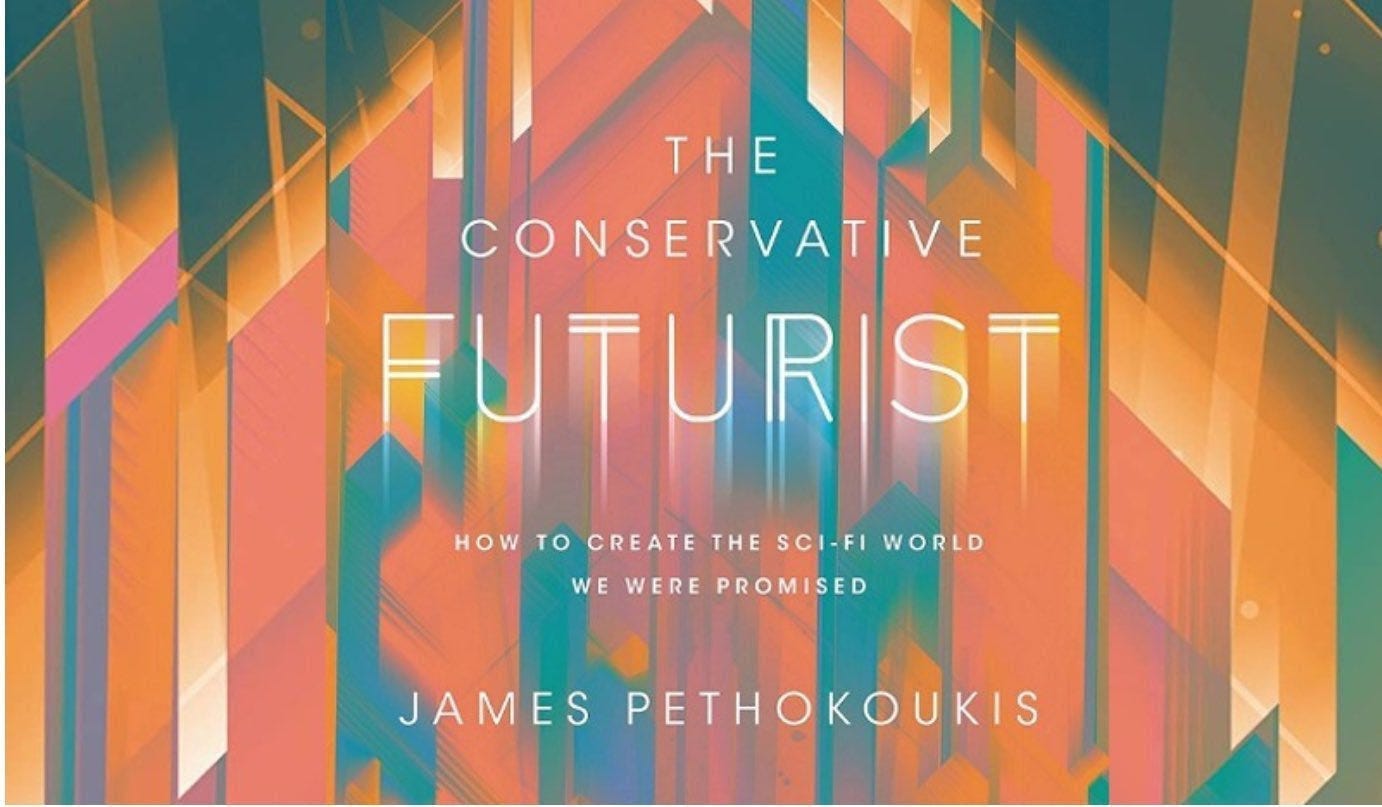🗽 The America we have, the America we could have
On this Election Day, thinking about possibilities
It’s my hope that whatever the outcome of today’s (this week’s?) American election, the current pro-progress, Up Wing trends are so strong as to be impervious to any reasonable range of bad public policy. I’m talking here about both the cluster of important 21st-Century technologies (especially in AI, biotechnology, energy, and space) as well as a revived pro-growth, pro-abundance attitude. Across a wide range of the American political spectrum, there’s a realization that it’s become too hard to build in this country and that a lack of abundance — especially in energy and housing — is a real problem. This a critical advance.
Now, I’ve previously argued that opinions about nuclear energy provide a good encapsulation of views about abundance, techno-solutionism, and risk. Good news, then, that American support for nuclear energy has surged since the pandemic.
History, unfortunately, argues that bad policy can badly slow progress. That’s sort of the whole point of my 2023 book. If we had made better decisions over the past half-century — especially in regulation and science investment — we would today live in a wealthier, healthier America and world … and be spreading across the Solar System. Yes, there should already be flying autonomous electric cars, but far more than that.
Imagine an America that is two or three times as wealthy.
Imagine an America running entirely on clean energy coming from nuclear fusion and solar.
Imagine an America where “online education” means an immersive virtual reality experience with a specialized AI tutor or even brain-to-brain learning.
Imagine an America where we live longer and better, one where 100 is the new 70 and cancer a mere medical annoyance.
American travelers to Europe can do so via sub-orbital hypersonic flight.
Americans are living and working in orbit, as well as on the Moon and Mars.
Antimatter space engines are coming online, bringing distant stars within reach of human exploration.
And no matter where an American calls home, they have zero worry about catching a nasty virus — whether corona or influenza — having received a universal vaccine at birth.
By the way, Molten Ventures, a London-based VC firm, has just released a stunning Up Wing short film about the possible world of 2054 that “showcases the transformative potential of Molten’s portfolio and the role of technology in shaping our world.” Definitely check it out.
But let’s take a step back and look at our near-future. In 2026, the United States will celebrate its Semiquincentennial, 250 years and counting. Hey, there’s a logo and everything:
Interregnum: I didn’t know this logo even existed before I started writing this essay. It’s worth checking out a 2023 New York Times piece by Callie Holtermann on its creation. The swirling, red-white-and-ribbon was designed by the same firm that did the excellent 1976 bicentennial logo, by the way.
In my book, I jump further ahead, all the way to the Tricentennial in 2076, with a letter to the USA of that future:
My fellow Americans of 2076: Hope all is well. I’m just going to assume this book was a monster best-seller, one that not only allowed me to build a Malibu mansion in the style of Tony Stark’s from the successful Iron Man trilogy (did they ever recast Robert Downey Jr., or just deepfake him?), but—more importantly, I assure you—also played a pivotal role in providing a path forward to the Up Wing future that is your present. Humbly, you’re welcome.
Likewise, I’m going to assume that you, like your parents and grandparents, are living through another amazing American Century where the USA remains the indispensable nation and leader of the free world, pushing forward the frontiers of both technology and human freedom. The latest version of Tomorrowland at Disneyland Luna is probably pretty awesome. I’m also assuming that American know-how played a critical role in developing AI as a valued helper to humanity, sources of abundant clean energy, technology to remove excess carbon from the air, a thriving orbital economy, all manner of universal vaccines for disease and treatments for chronic conditions. Existential risks from killer comets to viruses now seem more manageable, I’m guessing. And even if this planetary home were under lethal threat, humanity is now able to permanently live elsewhere—a place, perhaps, where kids might attend Nikola Tesla Academy, the most prestigious school in Musk City, located in Valles Marineris on the Red Planet.
But I’m sure lots of bad things have happened, too, as will always be the case. Perhaps another Engel’s pause as economies adjusted to greater automation. Maybe another accident with a new energy source or a space mission. I would like to think depressions, pandemics, and wars were obsolete, but in a world with flawed humans that is probably hoping for too much. I pray you are living in a future worthy of the risks taken to create it, one that also makes you confident to take more risks to create an even better tomorrow. And I hope to deliver this letter to you in person.
On sale everywhere The Conservative Futurist: How To Create the Sci-Fi World We Were Promised
Micro Reads
▶ Economics
The Immigration-Wage Myth - The Atlantic
▶ Business
▶ Policy/Politics
Moving Past Environmental Proceduralism - Asterisk
How much is a rare bee worth? - Marginal Revolution
Politicians Aren’t What Make America Great - WSJ Opinion
▶ AI/Digital
AI and Finance - SSRN
▶ Biotech/Health
▶ Clean Energy/Climate
Future of US energy goes to the ballot box - E&E News
▶ Space/Transportation
▶ Up Wing/Down Wing
▶ Substacks/Newsletters
How Much Money from a Confiscatory Tax on the Uber-Wealthy? - Conversable Economist










